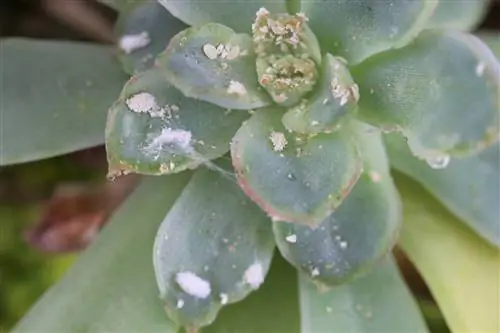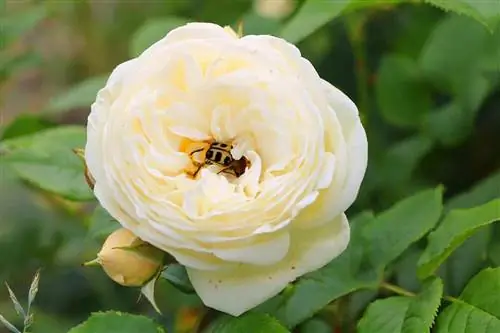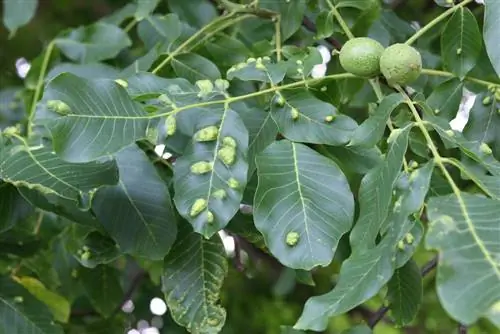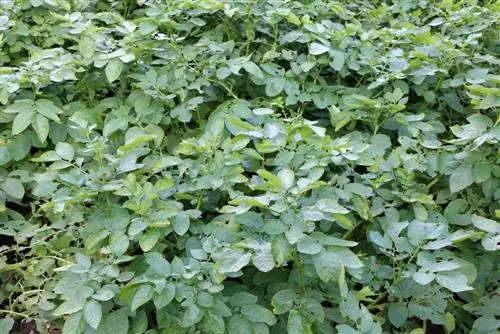- Author admin [email protected].
- Public 2023-12-17 03:39.
- Last modified 2025-01-24 12:45.
In winter there is a particularly high risk that houseplants will be infested with aphids or spider mites. Bugs are simply no longer uncommon at this time of year. The pests ultimately take full advantage of it and are very clever.
They often attack potted plants that are weakened by the heating air and little light. The leaves turn yellow, curl up or even develop holes. If this is the case, you simply have to act quickly so that the other plants are not infected.
The most well-known houseplant pests are probably aphids. The infestation of a plant can be seen primarily in the small, green animals that form colonies on the shoots and leaves. The animals suck the juice from the plants and damage the plant parts in the process. The sticky coating on the leaves comes from the sugary excretions of the aphids. Balcony and potted plants that are brought indoors in winter are particularly susceptible to these animals.
Of course there are a number of pests that are typical in different seasons. However, the means to combat this are different. However, with a few tips and tricks, everyone can get pests under control and care for their plants. There are even some home remedies that will help get rid of the pests quickly and ensure he althy and beautiful plants.
Tips and help with the various pests
Whiteflies
The symptoms of this pest are easy to recognize. The leaves of the plant yellow and wilt. In addition, if the infestation is particularly severe, they can dry out completely. The little animals are just 2 mm in size and are usually visible when the leaf of the plant is moved. The white larvae of the flies suck up the plant sap and secrete a sticky honeydew. Prevention: In order to prevent whiteflies, it is important to avoid dry and warm air in your plants. If the plant is infected despite all of this, a special shine spray must be used so that the whiteflies can be combated.
Aphids
The stunted growth, the curled leaves and, above all, the sucking of the plant sap. These are all signs of aphids. Prevention and control: Dry and warm air often lead to aphids. Despite all this, these can always be combated. If the infestation is relatively small, washing the plant is often enough. However, if the infestation is worse, you can use plant sticks that are aimed directly at pest control. Sprays against aphids, which can be found in every garden center, are also effective.
Mealybugs or mealybugs
If a plant is affected by these, the leaves will become yellowish and stunted after a while. The lice even affect the growth of the plant and form cotton-like and sticky structures, especially on the undersides of the leaves. In addition, these pests also suck up the plant sap. Prevention and control: As with all other pests, it is important that the room is not too dry and warm. After all, mealybugs are clearly visible. Accordingly, you can remove them directly from the plant with cotton wool or tweezers. A spirit soap solution can be helpful to finally combat it. Australian ladybirds are often used as beneficial insects.
Mini flies
White lines on the leaves and yellowish colors on the undersides of the leaves. This often shows an infestation of a mini fly. This pest even causes the leaves to die over time. The eggs and maggots of this pest are very difficult to see. However, you can spot the flies straight away. Prevention and control: You can remove the small flies directly using yellow plates or a vacuum cleaner. However, you should make sure that you fight the adult animals directly so that they can no longer lay eggs. The flies should therefore only be removed at the base of the leaves. Chemicals or even other beneficial insects have little effect on this pest.
Scale insects
White brown caps can be found directly on the plant of this pest. There is also a sticky coating there. The plant gradually appears weakened as the lice suck the sap from the plant. Prevention and control: A balanced plant diet is very important so that pests such as scale insects cannot form on the plant. Should an infestation occur despite all of this, the plants should be isolated immediately. The shields should then be carefully removed with a knife and used a spray to remove the remaining pests from the plant. There are now also some plant protection products that can be more than helpful in this area.
What you need to know about pests on houseplants
With just a few tips and help, it is no longer difficult to combat pests on houseplants these days. In most cases, home remedies or beneficial insects are best suited to save the plant from further pests. With a little caution and a good eye, a plant no longer has to suffer from pests. A houseplant that is in an optimal location and is watered correctly is a tough nut to crack for most pests! Unfortunately, the houseplants are still watered like in summer, which means that the plants are often very wet or the exact opposite, too dry! This weakens the plants quite a bit. In this state they are very susceptible to pests such as spider mites, aphids and lacewings:
- If these pests have spread, you should remove the infected houseplant from the pot,
- rinse them carefully with a mild soapy water
- and repot them in another pot filled with good potting soil.
- Clean the old pot well with soapy water and let it dry.
- Place the repotted plant in a bright place that is not too cool or too warm.
- East or north windows would be good. Pour briefly and water once a week.
- As soon as the sun shines more strongly, water the plants two to three times a week and fertilize once a week.
- It's best to briefly stick your index finger into the pot with the soil and try how moist the soil feels.
- The soil must not be wet - except for papyrus, this plant can stand in water.
- Continue to observe the newly potted plant and if necessary wipe it carefully again with soapy water.
Special: Fighting spider mites
Spider mites appear on houseplants, especially in the winter months. These insects can only survive in relatively dry air and therefore find ideal conditions in heated living spaces where the air dries out easily due to heating.
There are hundreds of different types of spider mites, but hobby gardeners mainly have to struggle with the common spider mite. It is only about half a millimeter in size and is therefore difficult to detect. However, an infestation can be recognized by the light spots on the leaves, which are caused by the sucking activity of the insects. Like aphids, spider mites suck the sap from the leaves and thereby damage the plant. Fine cobwebs can also appear. The easiest way to combat spider mites is to increase the humidity. You also make life difficult for them by regularly spraying the leaves of the plants.
If the infestation is already quite large, the entire plant can simply be showered off. It is then placed in a large plastic bag and tied at the top. This creates high humidity inside the bag. It not only ensures that the adult insects, but also the subsequent generations die as soon as they hatch from the eggs. For this treatment, however, the plant must remain in the bag for a few days.
Sprays from the nursery also have good results. They are made on the basis of various substances. Their natural enemies are also suitable for combating spider mites. These include:
- lacewings
- Predatory mites
- Ladybug
- Parasitic wasps
These insects or their eggs or larvae are also sold commercially and are primarily used in greenhouses and larger winter gardens.






